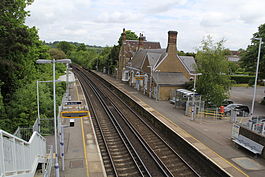Eynsford railway station
| Eynsford |
|
|---|---|
 |
|
| Location | |
| Place | Eynsford |
| Local authority | District of Sevenoaks |
| Grid reference | TQ535649 |
| Operations | |
| Station code | EYN |
| Managed by | Southeastern |
| Number of platforms | 2 |
| DfT category | E |
| Live arrivals/departures, station information and onward connections from National Rail Enquiries |
|
| Annual rail passenger usage* | |
| 2011/12 |
|
| 2012/13 |
|
| 2013/14 |
|
| 2014/15 |
|
| 2015/16 |
|
| History | |
| 1 July 1862 | Opened |
| 6 January 1935 | Electrified |
| May 1962 | Closed (Goods) |
| National Rail – UK railway stations | |
| * Annual estimated passenger usage based on sales of tickets in stated financial year(s) which end or originate at Eynsford from Office of Rail and Road statistics. Methodology may vary year on year. | |
|
|
|
Eynsford railway station serves Eynsford in Kent. Train services are provided by Southeastern and Thameslink.
The ticket office, on the 'down' side, is situated in the substantial station building. This is manned only during part of the day; at other times a PERTIS passenger-operated ticket machine issues 'Permits to Travel' - which are exchanged on-train or at manned stations for travel tickets - and is located at the foot of the stairs leading from the car park to the Ashford-bound platform.
The platforms are connected by a concrete footbridge - a typical product of the Southern Railway concrete factory at Exmouth Junction. There is a small car park (charges apply) at the entrance to the station.
The Swanley to Sevenoaks Bat & Ball line was opened on 2 June 1862, by the London, Chatham and Dover Railway, initially with just a single track. The station at Eynsford came into use the following month, with two platforms and a passing loop; the second track came in 1863.
The main station building is on the "down" side, two storeys high, with chimney stacks and arched window frames. On the "up" side is a shelter with an elaborate valance and sides for protection from the weather. The track was crossed at ground level until a lattice footbridge was built in about 1910. The signal cabin was positioned at the southern end of the "up" platform.
Eynsford's goods yard was positioned on the "down" side, to the south of the main building, and comprised a pair of sidings, one of which passed over a wagon turntable through the pitched-roof goods shed. The platforms were extended twice, first in 1894 and again in 1932 when they were lengthened at their southern ends, requiring the demolition of the signal box. This was replaced by a porch on the ground floor of the station building's platform side.
Electric services between Bickley and Sevenoaks were introduced on 6 January 1935, when the station lost its lattice footbridge to a prefabricated concrete replacement. Goods traffic ceased in May 1962 and the goods shed was demolished soon after.
...
Wikipedia
